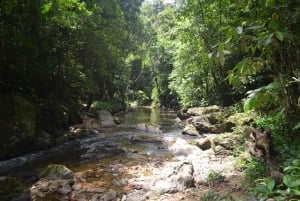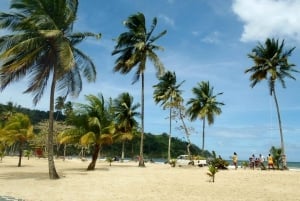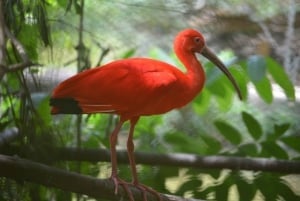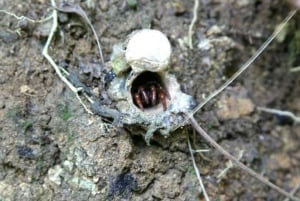Tobago
Tobago
At approximately 300km2 Tobago is less than half the size of Trinidad. The narrow island features a hilly spine down its center, the Main Ridge, of which the highest point Pigeon Peak is 550 meters. Tobago’s economy is largely tourism based and so you will find most of the working class employed in the thriving sector.
Tens of thousands of tourists enter the island each year by way of sea, on ferries from Trinidad, at the Scarborough Port and by air at the Arthur Napoleon Raymond Robinson International Airport, named after the island’s most accomplished son former Prime Minister and President of the Republic ANR Robinson. The Fast Ferry takes about 3-4 hours between islands while the flight is less than 25 minutes.
Tobago is also a popular holiday getaway for many “Trinis” as the island provides the perfect change of pace from the hustle and bustle of everyday life in Trinidad.
South West
Store Bay, possibly Tobago's most popular public beach is located on the doorstep of a large number of hotels, guesthouses, holiday apartments and is just about five minute walk from the airport. The beach is usually busy with activities such as snorkeling and swimming. Many of the Glass Bottom Boat tours operate from Store Bay, taking tourists to the Nylon Pool and Buccoo Reef.
This small 650 ft (200 m) beach is also the site of the Great Race an annual powerboat competition that takes racers on a challenging course between both islands. It is one of the beaches with lifeguard services. There are changing rooms and toilets and a variety of small shops and vendors, including several very well-known crab 'n' dumpling vendors.
Pigeon Point arguably Tobago’s most beautiful beach and home to the famous thatch-roofed jetty which has become an internationally recognized signature theme for Tobago.
The peninsula became the property of the Tobago House of Assembly (THA) in late 2005 and was renamed Pigeon Point Heritage Club. There is an entry fee of TT$18 (US$3/£2) per person (children aged 6-12 half-price and children under 6 free).
Bucco Reef and Nylon Pool. The reef has been named one of the spectacular sights to behold in the world. A two and a half hour ride in a glass bottom boat will give you a prolonged glimpse into a delightful colorful underwater world and countless photo opportunities. The Nylon Pool, a shallow clear swimming pool located in the middle of the ocean, is a wonder to behold. It’s the perfect place to be photographed as it captures in a single shot what Tobago life is all about-finding the beauty in simplicity. Tours can run from TT$50–150 depending on the tour operator and package.
Scarborough has been the capital of Tobago since 1769 and is located in the sheltered harbor of Rockly Bay. It is a small market town that still has and old colonial look and feel with old stone and wooden structures strewn between fast food joints, out door markets and bars. This is your port of entry when you disembark the ferries from Trinidad and you can find all the basic services here as well as medical attention if needed. Scarborough has a population of about 26,000 representing half Tobago’s population. Some consider it the busiest and loudest side of Tobago’s shy reserved personality.
The peace and tranquility of the nearby Scarborough Botanical Gardens is more in keeping with the pace of life on the island. Over 100 years old the gardens sit on 17 beautiful acres on the outskirts of the capital. You don’t have to be a botanist to appreciate its exotic equatorial foliage. It’s a great place to picnic, take a romantic stroll and capture gorgeous holiday images.
Fort King George is a necessary visit for all history buffs. It is located at 84 Fort St in Scarborough and is the best preserved historical monument on the island. Built by the English in 1779 it was later captured by the French and then tossed back and forth among various conquerors until an accidental explosion in 1847 blew off its roof.
The Tobago Museum is located in the Fort’s Barrack Guard House and has a rich display of aspects of Tobago’s history.
Leeward Coast
The calmer of Tobago’s two coastlines and bejeweled with coral reefs this side of the island offers visitors excellent swimming, snorkeling, water-skiing, wake-boarding and surfing.
After leaving Pigeon Point drive east on Milford Road for a couple of miles then turn left onto Shirvan Road. Head another couple of miles till you get to Mount Irvine Golf Course. Tobago’s legendary Easter Tuesday goat and crab racing and the infamous Sunday School street party are in Buccoo. Past Buccoo, some of Tobago’s most exclusive hotels can be found along the coast and hillsides around Mount Irvine, Stonehaven and Grand Courland Bays.
Mount Irvine Bay is a popular surfing spot where you can catch that perfect swell or get that long overdue surf lesson from Trinidad and Tobago’s local surf legend Jason Apparicio.
The Grafton Caledonia Bird Sanctuary offers the avid bird watcher the chance to cover even more territory. It is located near Black Rock village and features many nature trails and scenic hikes. The birds interact well with visitors and you may even be able to coax a few into hand feedings.
Mystery Tombstone still baffles locals and visitors alike. Of the 1783 death of Betty Stivens and her baby it says: “She was a mother without knowing it, and a wife without letting her husband know it, except by her kind indulgence to him”, adding that Mr Stivens would “deplore her death” for the rest of his life. Many interpretations of this farewell have been offered over the years, of which the most plausible is that Betty died in childbirth after a short marriage marked by kindness and indulgence.
Overlooking Turtle Beach and Courland Bay is Plymouth's Fort James, one of the oldest forts in Tobago. Named after Jacobus (James), the Duke of Courland, this British Fort was attacked by revolting slaves in 1770. A battery manned by the militia was erected on the site in 1777. If you plan to continue up the Leeward coast, Plymouth is a good place to stock up on food and gasoline. There are no more gas stations for miles.
Arnos Vale Bird Watching and Waterwheel Park is another favorite with eco-tourist. Located next to the Arnos Vale Hotel near Plymouth the facility is home to several rare tropical birds. The nearby waterwheel park features a former sugar factory with perfectly preserved machinery, an old slave village and a small museum with artifacts. It is definitely worth a stop.
Englishman’s Bay is one of Tobago’s most beautiful and charming beaches. It has a cafe overlooking the beach, and stalls with handmade crafts. Swimming in its turquoise water is divine so if you've been looking for your own slice of paradise, you've found it!
You can't help but stop along the Northside Road and savour the magnificent view of Parlatuvier Bay. This beach provides good swimming, though currents can be strong and the surf a little unpredictable, so pay attention to the warning flags on the beach.
Bloody Bay has a more ominous name than its pristine beach of golden sand and turquoise water would suggest. Blame ancient battles. Venturing down the narrow winding path to the beach needs some determination, but there’s good swimming and snorkelling when you get there.
Further inland as you climb and wind upward along the edge of the mountainous Main Ridge and Forest Reserve, one of the best kept eco-tourism secrets in the Western Hemisphere. A guided tour into the rainforest is an absolute must! It extends for about the length of the island, from the North east tip and features virgin jungles.
Windward Coast
A drive along the windward coastline takes you through the heart of rural Tobago. Meander through quaint villages steeped in tradition and culture. Rum shops, wooden parlors and vegetable stalls filled with a kaleidoscope of colorful bounty can be seen along the hillsides.
Dwight York Stadium named for Tobago’s most acclaimed footballer, can be found on Bacolet Street from Upper Scarborough and is Tobago’s main international sporting venue.
Barbados Bay once housed Tobago’s first British capital, Georgetown. A fresh fish market operates here every evening except Sunday.
Tobago also offers a host of activities for the adventurous. Start inland at Roxborough with a hike to the beautiful Argyle Waterfalls Tobago’s highest waterfall. After a short fifteen-minute walk through lush rainforest a three-tiered cascading waterfall with an eighteen foot pool awaits. Informative guides are available to give you some history on this former cocoa plantation turned nature trail. It is recommended that visitors to the falls use a registered guide. Admission is only TT $30 per person.
Little Tobago Bird Sanctuary The Little Tobago Sanctuary, meanwhile, is located offshore on an islet called; you guessed it, Little Tobago. Tours to the sanctuary depart from the eastern fishing village of Speyside at 10 am daily. The 20 minute crossing can be a bit rough but is well worth the effort. Several extremely rare birds have made the islet’s arid hilly habitat their home including: Red Footed and Brown Boobies, Magnificent Frigate and Red Billed Tropicbirds.
King’s Bay A sheltered horseshoe bay with excellent dark-sand and shaded by coconut trees and gentle rolling waves. Good facilities, including showers, lifeguards and shaded cabanas. A good place to buy fresh fish and witness the tradition of "pulling seine". There is a small bay called Delaford Bay within the main bay.
Speyside is a divers paradise with frequent scuba diving and day trips to Goat Island and Little Tobago. Trips to Little Tobago cost around TT $128.
The fishing village of Charlotteville, with homes sprawling and tumbling down the hillsides to the glistening waters of Man o’ War Bay, with its flotilla of pirogues and diving pelicans. It’s a fitting climax to a drive full of wonderful scenery.
Don’t miss out on Pirate’s Bay, though. It’s a twenty-minute walk from Charlotteville’s northern end, and well worth the effort.











